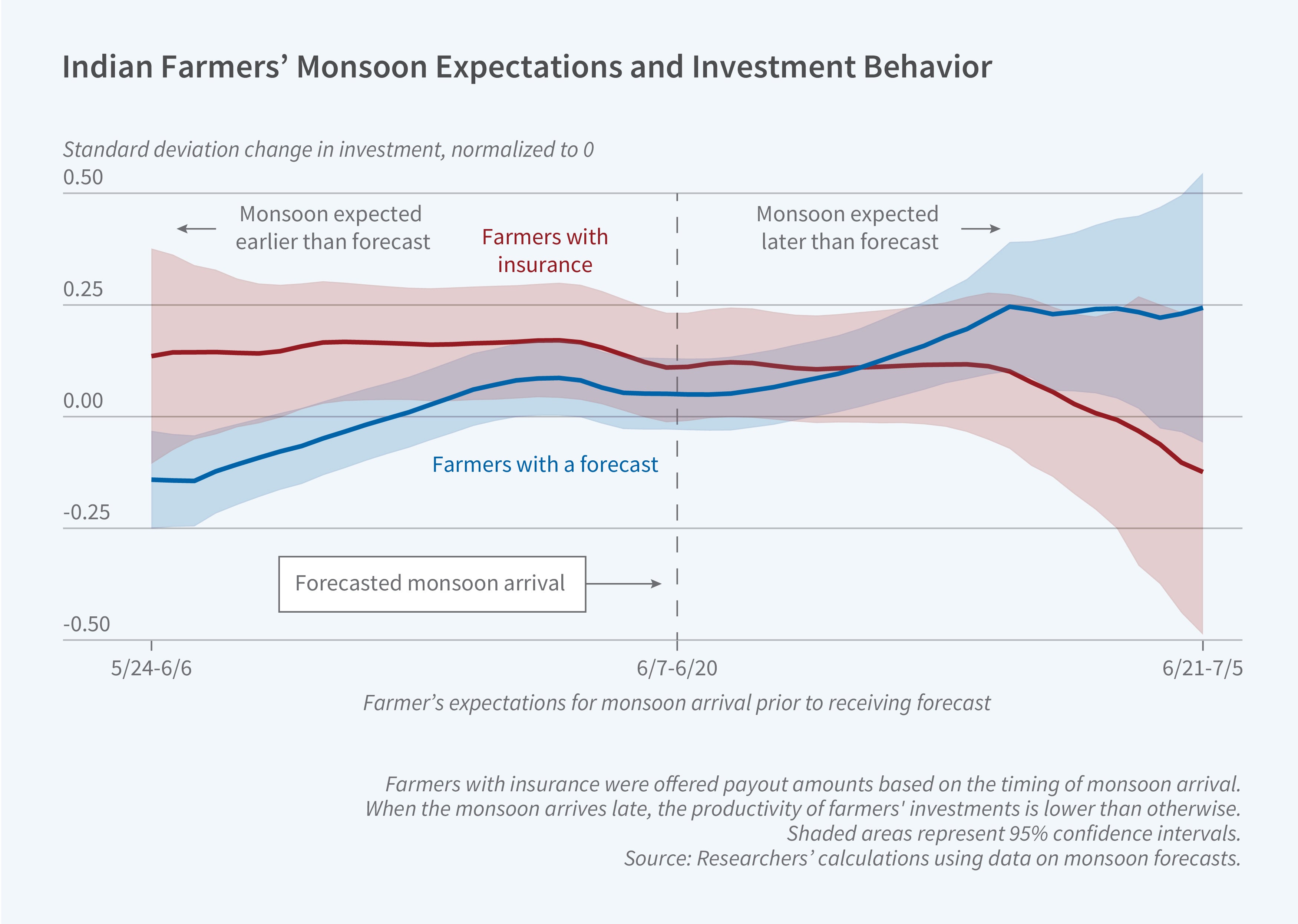Weather Forecasts and Farming Practices in India

Climate change is making weather patterns around the world more volatile, increasing risks for farmers. Providing farmers with accurate weather forecasts is one possible strategy for mitigating these risks. In Long-Range Forecasts as Climate Adaptation: Experimental Evidence from Developing-Country Agriculture (NBER Working Paper 32173), Fiona Burlig, Amir Jina, Erin M. Kelley, Gregory Lane, and Harshil Sahai report on a randomized trial in Indian villages that provided some farmers with a forecast of when the annual monsoon would begin. Farmers respond to news about monsoon timing by altering their production and investment choices.
Agriculture in the southern Indian state of Telangana, where the average landholding is 1 hectare, is dependent on the monsoon, which provides 80 percent of total annual rainfall. The timing of the start of the monsoon is highly variable from year to year. Early arrival of the monsoon is favorable for agricultural productivity. Traditionally, farmers rely on other farmers for weather information; there exists no official forecast of the monsoon’s onset in the state. At baseline, farmers’ prior beliefs about monsoon onset timing varied widely, with more optimistic farmers expecting the monsoon to arrive more than 2.5 weeks earlier than more pessimistic farmers.
The researchers randomized 250 villages in Telangana, sampling 5 to 10 farmers in each village, into a forecast group, an insurance group, and a control group. Farmers in the forecast group were offered an accurate forecast of the timing of the monsoon’s onset, delivered 4–6 weeks in advance of the monsoon’s arrival. Farmers in the insurance group were offered fully subsidized insurance against the monsoon onset date: they would receive no payout if the monsoon began less than two weeks later than usual, a small payout if it was 15–19 days late, a medium payout if it was 20–29 days late, and a large payout if it was 30 or more days late.
The forecast caused farmers to update their beliefs, bringing their expectations about the growing season more in line with the forecast. This also led to changes in their planting behavior.
Though all farmers received the same forecast, the researchers find that the farmers’ responses to this information differed depending on their prior beliefs. Optimistic farmers who had originally expected an early monsoon — and for whom the forecast provided “bad news” — reduced land under cultivation by 22 percent, were 32 percent less likely to add a crop type, and reduced agricultural expenditures by 10 percent. In contrast, pessimistic farmers who had originally expected a late monsoon — and therefore received “good news” from the forecast — increased land under cultivation by 15 percent, were 40 percent more likely to add new crops, and increased agricultural expenditures by 34 percent.
At the end of the growing season, while “bad news” farmers saw lower farm profits than the control group (in keeping with their reduced investments in agriculture), they shifted into nonagricultural production, increasing nonagricultural investment by 12 percent and nonagricultural business profits by 47 percent. Their overall savings (net of debt) increased by $560 per farmer. There was no change in agricultural profits for farmers who received good news, as higher spending on inputs canceled out the gains from increasing land under cultivation.
Insurance also caused farmers to change their behavior. In contrast to the forecast group, however, with insurance, pessimistic farmers did nothing, while optimistic farmers drove large positive impacts on land under cultivation and input expenditures. Forecasts and insurance work in different ways: forecasts provide information, allowing farmers to tailor their investments to the coming season, while insurance protects against downside risk.
In light of their findings that farmers adjust their behavior in response to forecasts, the researchers conclude that “long-range monsoon forecasts are a promising technology for helping farmers cope with increasing agricultural risks in a changing climate.”
—Whitney Zhang
The researchers thank the Becker Friedman Institute for Economics at the University of Chicago, J-PAL’s Agricultural Technology Adoption Initiative and King Climate Action Initiative, and the World Bank for generously funding this project.


